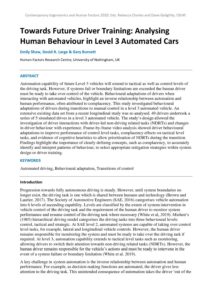| Document | Author Emily Shaw, David R. Large and Gary Burnett |
| Abstract Automation capability of future Level 3 vehicles will extend to tactical as well as control levels of the driving task. However, if systems fail or boundary limitations are exceeded the human driver must be ready to take over control of the vehicle. Behavioural adaptations of drivers when interacting with automated vehicles, highlight an inverse relationship between automation and human performance, often attributed to complacency. This study investigated behavioural adaptations of drivers during transitions to manual control in a level 3 automated vehicle. An extensive existing data set from a recent longitudinal study was re-analysed. 49 drivers undertook a series of 5 simulated drives in a level 3 automated vehicle. The study’s design allowed the investigation of driver interactions with driver-led non-driving related tasks (NDRTs) and changes in driver behaviour with experience. Frame-by-frame video analysis showed driver behavioural adaptations to improve performance of control level tasks, complacency effects on tactical level tasks, and evidence of cognitive heuristics to allow prioritisation of NDRTs during the transition. Findings highlight the importance of clearly defining concepts, such as complacency, to accurately identify and interpret patterns of behaviour, to select appropriate mitigation strategies within system design or driver training. |

